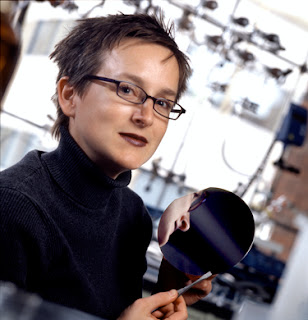"Computer chips are constantly getting smaller and smaller. There's an unrelenting decrease in size. And the question arises, how do you wire these things in?" said Jillian Buriak, University of Alberta chemistry professor and senior research officer at the National Institute for Nanotechnology. "If you're going to make something on the order of 22 or even 18 nanometres, then you'd better have a plug that's about that size, too."
A team of NINT researchers, headed by Buriak, has demonstrated an innovative technique for producing very small, conductive nano-wires on silicon chips. The technique can produce wires that are 5,000 times longer than they are wide and meet the need for connecting ever-smaller electronic components.
"You need very tiny wires to connect everything," said Buriak. "We've figured out a way to use molecules that will self-assemble to form the lines that can be used as wires. Then we use those molecules as templates and fill them up with metal, and then we have the wires that we want. You use the molecules to do the hard work for you."
The scale to which Buriak's research team is working is difficult to comprehend. In one example of Buriak's work, 25 parallel platinum nano-wires were made using this self-assembly process, with each wire measuring only 10 nanometers in width, but extending to a length of 50,000 - as long as a human hair is wide.
While the idea of wires 'self-assembling' sounds like something from science fiction, it's a natural process, says Buriak, who teaches chemistry at the U of A.
"You are the product of self-assembly. The way DNA forms a double helix is self-assembly. It's just that molecules will recognize each other, bind to each other, and then they'll form structures," she said. "And the molecules we're using are actually very simple. They're just polymers, just plastics that do that naturally."
While the new process could provide the solution for computer manufacturers looking for ways to increase the speed and storage capacity of electronics, it could also mean cheaper electronics as well.
"If you have to go and lithographically define one single wire, it's going to be painstakingly hard and expensive," said Buriak. "But if you can have a cheap molecule do it for you, that's great; that's going to be much cheaper, use much less energy and be a little more environmentally friendly."
The research findings are published in the journal Nature Nanotechnology.
NINT is a national research facility run by the National Research Council and the University of Alberta.
Related Links: Written by: By Ileiren Poon, ExpressNews Staff Contact: Ryan Smith ryan.smith@ualberta.ca 780-492-0436 University of Alberta
Technorati Tags: Nano or Nanotechnology and Nanotech and University of Alberta or nano-wires and lithographically or Press Briefing Tony Snow 09/12/07 VIDEO PODCAST and Lascaux Cave Paintings and Nanowire Coating for Bone Implants, Stents















No comments:
Post a Comment